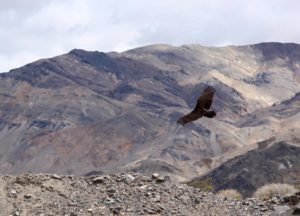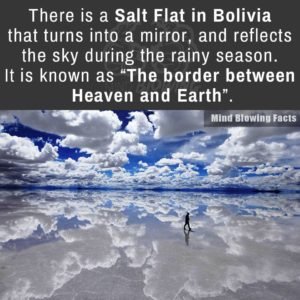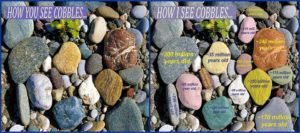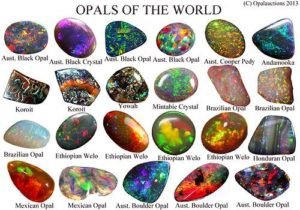COLORED SANDS OF THE SAHARA DESERT
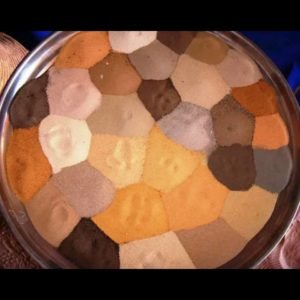
James Hutton is the father of geology. He envisioned the cyclical nature of geologic processes. Geology is a science that deals with the history of the earth and its life especially as recorded in rock. It is the study of earth’s structure and the forces that produce them, including earth tectonics.
There are 92 elements naturally occurring on earth. An element has only one kind of atom. Elements are created in the stars. Some elements are attracted to each other and some are not. When 2 atoms of hydrogen get very hot and combine into 1 atom of helium (dry ice), neutrons are released as energy causing more heat. In nuclear fusion, 2 atoms fuse together to form a heavier element. When nuclear fusion takes place in a cloud of hydrogen, so much energy is released a star is born. If the reactions are uncontrollable, the star explodes in a supernova and elements spew into space.
99% of the mass of the universe is made of 2 elements – hydrogen and helium.
99% of the mass of the earth is made of 8 elements: iron, oxygen, calcium, silicon, magnesium, aluminum, sulfur, nickel.
Elements in the human body:
oxygen 65%
carbon 17.5%
Hydrogen 10.2%
nitrogen 2.4%
calcium 1.6%
all others 3.3%
Gold is one of the few elements found in a pure state. Its most common occurrence is in quartz. Bismuth is the heaviest element not radioactive. There are 6 elements that cannot be combined with other elements: Helium, neon, argon, krypton, xenon, and radon. They always exist as single atoms.
A mineral is made of one or more chemical elements. Chemicals in a mineral account for its softness, shine, and other noticeable properties. Anything not a plant or animal is a mineral. Many things are made of minerals: houses, cars, glass, dishes, pots, knives, paint, bridges, signs, jewelry, furniture, clay, chalk, talc powder, cement, sidewalks, roads, pipes, and wires. Almost all minerals are found in a solid state but water.
WATER is a liquid mineral. Ice is a water crystal. Flint is one of the oldest minerals used by man. Salt is a mineral known as Halite that comes from the sea. People used salt and turquoise for money long ago. We eat minerals in our food: liver = iron, milk and cheese = calcium, salt = iodine, beans & peas = copper and manganese, fish = phosphorus.
Of the rock forming minerals the most common are quartz, feldspar, & mica. Quartz is the most important rock-forming mineral and has many colors. Ex. smoky quartz, citrine, amethyst, rose.
Metals are minerals that have certain properties like shiny and good conductor of heat and electricity, and can be pressed, hammered, and bent such as gold, copper, silver, iron, aluminum and steel (foil, tin and aluminum cans). A television has 35 minerals and the telephone has 40.
Gemstones are minerals that have beauty, hardness, rarity, and sometimes translucence. Of the gemstones, emerald and diamond are the most rare.
Rock is an aggregate of one or more minerals and they are the building blocks of the earth’s crust Many rocks contain silica (SiO2); a compound of silicon and oxygen that forms 74.3% of the Earth’s crust. This material forms crystals with other compounds in the rock. The proportion of silica in rocks and minerals is a major factor in determining their name and propertiesThe types and abundance of minerals in a rock are determined by the manner in which the rock was formed.. Rocks are geologically classified according to characteristics such as mineral and chemical composition, permeability, the texture of the constituent particles, and particle size. Most rocks contain about 6 minerals. A mineral is homogenous. (molecules of every mineral are arranged in a particular crystalline structure that dictates its shape.)
MOON ROCKS
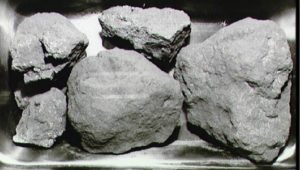 THE MOST VALUABLE ROCKS ON EARTH!
THE MOST VALUABLE ROCKS ON EARTH!
The Rock Cycle is the dynamic transitions through geologic time among the three main rock types: sedimentary, metamorphic, and igneous. The Rock Cycle explains how the three rock types are related and how processes change one type to another over time. The cycle is driven by plate tectonics and water and temperature.
Rocks are many colors, sizes, and shapes and are found everywhere: pebbles, stones, boulders, mountains, and islands. They can be round, square, spiked, plated, smooth, rough, hard or soft. Some have eyes. Some have stars. They may be clear, black, or mixed colors, magnetic or radioactive. Quartzite is metamorphosed sandstone found in the high Blue Ridge Mts. It is the most durable rock known. Quartz consists of rock crystals such as rose, amethyst, tigers eye.
ROCK QUARRIES are areas where rock is mined. Ex. Granite, sandstone, marble, limestone. Gravel is crushed rock. Rock is eroded by wind and water continually and is created through volcanoes. Famous rocks are: the Grand Canyon, Clingmans Dome, the Petrified Forest, and Caesars Head
The cryptocrystalline group of rocks has a crystalline structure so fine you cannot see particles under a microscope. It includes agate, bloodstone, carnelian, onyx, moss agate, chert, flint, and jasper.
Schistocity is how a rock breaks. Some crumble, flake, or break in one direction. Some rocks fluoresce and glow under ultraviolet light. Ex.willemite, calcite, hardystonite, autunite, scheelite, hydrozincite, semi-opal, wernerite
Moon rocks are the most expensive rocks ever collected and are a symbol of a dream come true. They are lumps of blackish rock. There is no trace of fossils or oceanic matter on the moon. Moon rock mineral composition is similar to earth rocks but differently combined. There are 2 types of rock on the moon: igneous rocks and breccias. There is the highest content of elements with high melting points and few with low melting points (opposite on earth). They are a mixture of pieces of iron, meteorites, igneous rock, and glassy fragments. The soil is a high content of nickel, cadmium, zinc, silver, gold, and copper. The soil has a high content of meteorite chips formed 3-7 billion years ago.
IGNEOUS ROCKS are formed from fire deep in the earth. Magma is molten rock. Magma is the Greek word for dough. Hot lava spews forth from volcanoes. The plutonic
rocks solidify deep in the earth’s crust. Basalt and granite crystallize in magma. Some minerals are formed by direct crystallization from a gas. Sulfur crystallizes from a gas released at volcanic vents around hot springs and forms a powdery crust or large crystals, burns with an unpleasant odor, is used in insecticides and to make paper, matches, and explosives.
Granite is quartz, feldspar, and mica and is the most common igneous rock. It is molten rock that cools underground before it gets to the surface. Huge rocks are created this way and can be red, pink, yellow, and brown. A good place to find them is around old volcanoes.
Iron pyrite is a cube made of iron and sulfur. It forms good crystals, comes from the decay of animal and vegetable matter, forms nodules in shale and chalk, occurs in irregular masses, and is pale brass yellow and sparks when struck.
Galena is lead and sulfur, the most common mineral with lead, cubes splits easily and are large masses in limestone. It is heavy and shines silver gray.
Magnetite is iron and oxygen. The crystal is the same as diamond and it is strongly magnetic. ex. Lodestone (points north.)
Hematite is Greek for blood. Kidney ore makes a red streak and is the most important source of iron. It is widespread in sedimentary rocks and causes the red color of many rocks.
Corundum has 6-sided barrels and spindles such as ruby, sapphire and 6 rayed stars.
Feldspar occurs in almost all igneous rocks and is white, light pink and green. It is changed to clay by wind and water. We find granite with pink feldspar or white feldspar.
Almandine and staurolite are plutonic. Staurolite is found at Mineral Bluff, Georgia and in Virginia.
Lava is a common igneous rock. If lava cools fast it forms obsidian that looks like glass. Other igneous rocks are diorite, felsites, basalt, pumice, granite, and feldspar.
Pyrolucite consists of manganese and oxygen and forms fernlike shapes in sedimentary rock or thin radiating crystals that form nodules at the bottom of the sea with copper, iron, and nickel.
Stone Mt. in Georgia is an example of a rock formed at great depths. Uplifts and erosion have made it visible. The following mountains were formed from slow folding glaciers: Swiss Alps, Appalachians, Atlas, Urals, Rockies, and Himalayan. Volcanic domes and cones are faulted and folded peaks. Faulted mountains rise and fall. Ex. Kilimanjaro, Fujiyama, Vesuvius, Etna. Dome Mt. of Utah is an example of volcanism but it does not erupt.
SEDIMENTARY rocks are mostly made under water from rock, sand, and mud. The top layer puts pressure on the bottom and they change into sandstone, limestone, shale, marble, slate, schist, coal, conglomerate, and gypsum (chalk.)
One finds limestone where land was once under water and it forms only under water.
Conglomerate is made in old streams and riverbeds. Sandstone can be gray, yellow, red, and brown. Shale is created from fine silt and mud and has the odor of wet earth. Ex. Limestone, sandstone, mudstone, dolomite, salt, coal. Stalactites in caves are sedimentary rock formation
METAMORPHIC rocks are formed from heat and pressure changes 40 miles below the earth’s surface in 1% of the earths crust. Limestone turns to marble.
Shale turns to slate. Schist is from mudstone and shale and sparkles with mica.
Serpentine is green and slippery to the touch as if covered with wax or soap. Quartzite is formed from sandstone. The most famous metamorphic rock is marble Ex. Talc, marble, serpentine, quartzite, slate, schist.
CRYSTALS The most solid substances are crystalline and have a shape. Diamond as a natural crystal has no sparkle.
There are 6 Systems of crystals:
- Cubic = halite
- Orthorhombic = sulfur
- Tetragonal = rutile
- monoclinic = epppidote
- Hexagonal = calcite
- triclinic = amazonite
How to identify rocks: Where did it come from? How hard is it? We use the hardness scratch test.
Hardness scale:
Talc is metamorphic and the softest
Gypsum is sedimentary and colorless or white. Ex. plaster of parries, chalk
Calcite is colorless or white and found in all groups. Ex. Iceland spar
Fluorite is colorless or many colors
Apatite yellow is most common
Feldspar is one of the most common minerals on earth and turns to clay
Quartz is most common
Topaz
Corundum ex. Ruby, sandpaper
Diamond is the hardest mineral, is rare and formed from compressed carbon.
Use a streak plate to identify rocks. Some make a colored streak. You can identify them by origin, hardness, streak, and weight.
Fossil is a Latin word meaning “dug up”. Fossils animals and plants are found in sedimentary rock such as limestone. Wood becomes petrified,
Meteorites – Gibeon in 1838 fell in Namilua Africa. Henburg fell in Australia and caused 13 craters in 1½ sq. miles in central Australia. Canyon Diablo caused the Arizona meteor crater and was the first meteor crater identified on earth. An iron meteor fell 40,000 years ago. It was 80 ft in diameter and weighed 63,000 tons. The impact crater is 4,200 feet in diameter. The floor is 750 feet below the rim. 150 impact craters have been discovered around the world
To think about:
Tools you would need for mining, a rock hound, rockslide, rock climbing, between a rock and a hard place, faith as a stone in a box, honey from the rock, rock and roll! Get the lead out of your shoes
PUMICE IS THE ONLY ROCK THAT FLOATS ON WATER!

Death Valley